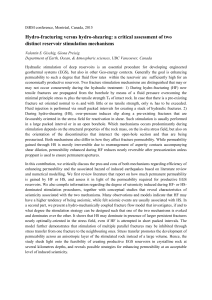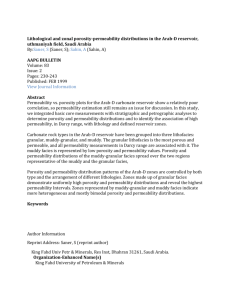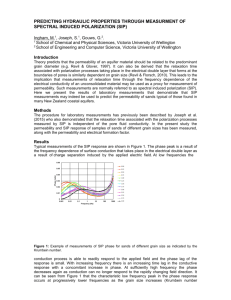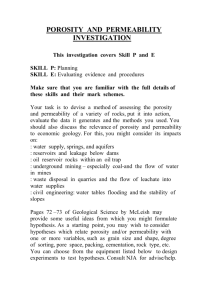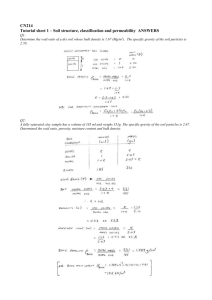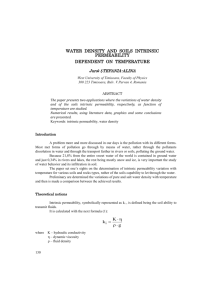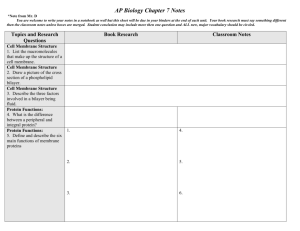effect of change in the coefficient of permeability on
advertisement
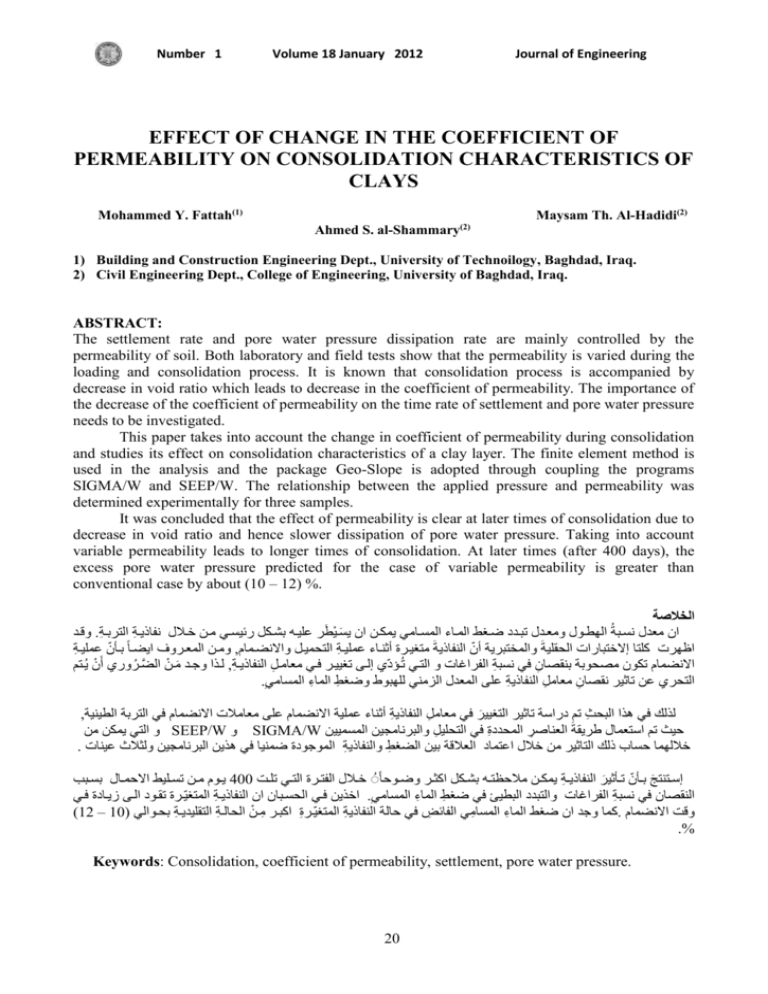
Number 1
Volume 18 January 2012
Journal of Engineering
EFFECT OF CHANGE IN THE COEFFICIENT OF
PERMEABILITY ON CONSOLIDATION CHARACTERISTICS OF
CLAYS
Mohammed Y. Fattah(1)
Maysam Th. Al-Hadidi(2)
Ahmed S. al-Shammary
(2)
1) Building and Construction Engineering Dept., University of Technoilogy, Baghdad, Iraq.
2) Civil Engineering Dept., College of Engineering, University of Baghdad, Iraq.
ABSTRACT:
The settlement rate and pore water pressure dissipation rate are mainly controlled by the
permeability of soil. Both laboratory and field tests show that the permeability is varied during the
loading and consolidation process. It is known that consolidation process is accompanied by
decrease in void ratio which leads to decrease in the coefficient of permeability. The importance of
the decrease of the coefficient of permeability on the time rate of settlement and pore water pressure
needs to be investigated.
This paper takes into account the change in coefficient of permeability during consolidation
and studies its effect on consolidation characteristics of a clay layer. The finite element method is
used in the analysis and the package Geo-Slope is adopted through coupling the programs
SIGMA/W and SEEP/W. The relationship between the applied pressure and permeability was
determined experimentally for three samples.
It was concluded that the effect of permeability is clear at later times of consolidation due to
decrease in void ratio and hence slower dissipation of pore water pressure. Taking into account
variable permeability leads to longer times of consolidation. At later times (after 400 days), the
excess pore water pressure predicted for the case of variable permeability is greater than
conventional case by about (10 – 12) %.
عقبد.ُنفسذيبُ اهر بب
ّ اي بس
ُببنن عللْب
اه رب عئإ أ َ طن يبر
الخالصة
َ ْسب ط
و علْب بشبك ئيْسب مب الب ل
ي
ان
يلكب
اهلسبسم
اهلبسا
ابما
دةبدط
عمعبدل
ل
اهطوب
ُنسبة
معدل
ان
َ
َ
َ
ّ ُاظط ت كلرس إالالرةسئات اهحقلُْ عاهلخرة ي
عمب اهلعب ع, أن اهنفسذيُ مرمْب أننبسا عللْبُ اهرحلْب عاالن بلس
هباا عدبد َمب ط,ُاالن لس دك ن مصح بُ بنقصسن ف نسةُ اهف اغست ع اهرب دبّطّإ إهب دمْْب فب معسمب اهنفسذيب
. اهرح إ ع دسنْ نقصسن معسم اهنفسذيُ عل اهلعدل اهزمن هلطة ط عاما اهلسا اهلسسم
,ُْهاهك ف هاا اهةحث د طئاسُ دسنْ اهرمْْ َ ف معسم اهنفسذيُ أننسا عللُْ االن لس عل معسم ت االن لس ف اهر بُ اهوْن
ع اهر يلك مSEEP/W عSIGMA/W ْْحْث د اسرعلسل ط يقَُ اهعنسص اهلحدط ف اهرحلْ عاهة نسمجْ اهلسل
. ال هطلس حسسب ذهك اهرسنْ م ال ل اعرلسط اهع قُ بْ اه ما عاهنفسذيُ اهل د ط النْس ف هاي اهة نسمجْ عهث ث عْنست
ّ إسببرنر َ بب
يب مب دسببلْا االحلببسل بسببة044 بنن دببننْ َ اهنفسذيببُ يلكب م حهرب بشببك اكثب عاب حسُ الب ل اهفرب اهرب دلب
االاي فب اهحسبةسن ان اهنفسذيبُ اهلرمّْب دقب ط اهب ةيبسط فب. اهنقصسن ف نسةُ اهف اغست عاهرةدط اهةوْئ ف اما اهلسا اهلسسم
(01 – 04 كلس عدد ان اما اهلسا اهلسسم اهفسيض ف حسهُ اهنفسذيُ اهلرمّْب اكةب مب ط اهحسهبُ اهرقلْديبُ بحب اه. عق االن لس
.%
Keywords: Consolidation, coefficient of permeability, settlement, pore water pressure.
20
Mohammed Y. Fattah
Maysam Th. Al-Hadidi
Ahmed S. al-Shammary
EFFECT OF CHANGE IN THE COEFFICIENT OF
PERMEABILITY ON CONSOLIDATION
CHARACTERISTICS OF CLAYS
د
decrease of the coefficient of permeability
on the time rate of settlement and pore
water pressure needs to be investigated.
Cavalcante and Assis (2002) showed the
influence of the permeability gradient
during the construction of tailings dams,
built by the upstream method, using the
hydraulic fill technique. During the
hydraulic disposition, two mechanisms
affect the tailings permeability: the
hydraulic
segregation
and
the
consolidation due to the staged
construction procedure. These mechanisms
influence considerably the permeability
distribution
along
the
fill
and,
consequently, the behaviour of the dam.
Results show that the pore pressure
immediately after deposition may reach
quite high values (532 kPa), but dissipates
in a short period of time (1 to 10 days).
Then, this effect should be taken into
account in a short-term stability analysis of
tailings dams. On the other hand, after
pore pressure dissipation, there is a gain in
the shear strength (13 %), which should
also be considered, but in a long-term
stability analysis of tailings dams.
The settlement rate and pore water
pressure dissipation rate are mainly
controlled by the permeability of soil. Both
laboratory and field tests show that the
permeability is varied during the loading
and consolidation process. The formula
proposed by Taylor (1948) and verified by
Tavenas et al. (1983) can be used to
represent variation of the permeability of
soft clay during the consolidation:
INTRODUCTION
Consolidation is generally related to finegrained soils such as silts and clays. Since
water can flow out of a saturated soil in
any direction, the process of consolidation
is essentially three-dimensional. However,
in most field situations, water will not be
able to flow out of the soil by flowing
horizontally because of the vast expanse of
the soil in horizontal direction. Therefore,
the direction of flow of water is primarily
vertical or one-dimensional. As a result,
the soil layer undergoes one-dimensional
(1-D) consolidation settlement in the
vertical direction.
Consolidation theory is required
for the prediction of both the magnitude
and the rate of consolidation settlements to
ensure the serviceability of structures
founded on a compressible soil layer.
Terzaghi’s theory of 1-D consolidation
makes
the
following
assumptions
including that the soil is homogeneous and
fully saturated, the solid particles and the
pore water are incompressible, the flow of
water and compression of soil are onedimensional (vertical), strains are small,
Darcy’s law is valid at all hydraulic
gradients, but the most important
assumption is that the coefficient of
permeability and the coefficient of volume
compressibility
remain
constant
throughout the consolidation process.
Terzaghi gave a theory of soil
consolidation based on the effective stress
principle, which was derived on several
ideal assumptions to get a simplified
theory. To avoid the limitations involved
in Terzaghi’s theory, many efforts are
being made by scholars to solve the
problems
in
practical
engineering
situations.
It is known that consolidation
process is accompanied by decrease in
void ratio which leads to decrease in the
coefficient of permeability. Effect of the
k ko .10
( eo e )
ck
(1)
where: eo : the initial void ratio,
e : the void ratio at the condition
under consideration,
k : the permeability,
ko : the initial permeability, and
ck : constant which is equal to 0.5
eo (Tavenas et al., 1983).
21
Number 1
Volume 18 January 2012
A semi-analytical solution was
presented by Ying et al. (2005) for the case
of void ratio e-log effective stress p and elog
permeability
conductivity
kv,
especially. The semi-analytical results
were compared with those obtained from
experimental investigations with a set of
advanced
consolidation
system.
Furthermore, the behavior of nonlinear
consolidation of soils is analyzed and the
differences between the semi-analytical
results and Davis’s nonlinear theory were
discussed. It was concluded that the semianalytical solution is a very effective
method for solving the difficult
consolidation problems taking varied
compressibility and permeability into
account. The degree of consolidation
defined by effective stress and by
settlement is different in this method. The
advanced consolidation system with back
pressure is an effective method for
analyzing the consolidation behavior of
clay. Fairly good agreement exists
between theoretical results and the
consolidation test results.
This paper takes into account the
change in coefficient of permeability
during consolidation and study its effect
on consolidation characteristics of a clay
layer.
Journal of Engineering
The identification and classification tests
included grain size distribution, Atterberg
limits and specific gravity. Table 1 shows
the index properties of the soils from the
three sites.
Consolidation test was carried out on
undisturbed soil samples according to the
specification of ASTM D-2435-02. For
each load increment, the coefficient of
consolidation, cv, was calculated using
Casagrande’s procedure in addition to the
coefficient of volume change, mv. Then
the coefficient of permeability, k, was
calculated according to the following
relation:
k mv . cv . w
(2)
where w is the unit weight of waater.
The relationship between the applied
pressure and permeability is plotted for
each sample as shown in Figure 1.
FINITE ELEMENT ANALYSIS:
SIGMA/W is a finite element software
product that can be used to perform stress
and deformation analyses of earth
structures. Its comprehensive formulation
makes it possible to analyze both simple
and highly complex problems. For
example, one can perform a simple linear
elastic deformation analysis or a highly
sophisticated nonlinear elastic-plastic
effective stress analysis. When coupled
with SEEP/W (another GEO-SLOPE
software product), it can also model the
pore-water pressure generation and
dissipation in a soil structure in response to
external loads. SIGMA/W has application
in the analysis and design for geotechnical,
civil, and mining engineering projects.
DESCRIPTION OF THE PROBLEM:
The problem consists of tracing the
settlement and pore water pressure
changes in a clay layer under the effect of
uniformly distributed load 80 kN/m2. The
finite element method is used in the
analysis and the package Geo-Slope is
adopted through coupling the programs
SIGMA/W and SEEP/W.
LABORATORY WORK:
In order to define the coefficient of
permeability as a function of the applied
pressure, a testing program was planned on
samples taken from three sites located in
Baghdad city. These soil samples are
named by S1, S2 and S3.
Hydraulic Conductivity Functions
Analyzing saturated seepage processes
requires establishing the hydraulic
conductivity versus pore-water pressure
relationship. In the case of a transient
analysis, the volumetric water content
function must also be defined. Both of
22
Mohammed Y. Fattah
Maysam Th. Al-Hadidi
Ahmed S. al-Shammary
EFFECT OF CHANGE IN THE COEFFICIENT OF
PERMEABILITY ON CONSOLIDATION
CHARACTERISTICS OF CLAYS
د
these functions can be either measured
directly in the laboratory or predicted
using a variety of methods. The
volumetric water content function can be
predicted from the grain-size distribution
curve and the hydraulic conductivity
function can be predicted using the
volumetric water content function and the
measured
saturated
hydraulic
conductivity.
The capacity of soil to conduct
water can be viewed in terms of hydraulic
conductivity (or the coefficient of
permeability). The hydraulic conductivity
is dependent on the water content. Since
the water content is a function of porewater pressure and the hydraulic
conductivity is a function of water content,
it follows that hydraulic conductivity is
also a function of pore-water pressure.
Figure 2 presents the form of the
relationship
between
hydraulic
conductivity and pore-water pressure. This
relationship is known as a conductivity
function.
until the yield point is reached. Beyond the
yield point, the stress-strain curve is
perfectly horizontal.
Plastic Matrix, Elastic-Plastic Model
In SIGMA/W, soil plasticity is formulated
using the theory of incremental plasticity
(Hill, 1950). Once an elastic-plastic
material begins to yield, an incremental
strain can be divided into elastic and a
plastic component.
Only elastic strain increments, de, will
cause stress changes. As a result, stress
increments can be written as follows.
d C e
d
e
(3)
Consequently, the yield function can be
written as follows in equation form.
F F ( x , y , z , xy )
(4)
An incremental change in the yield
function is given by:
The
variation
of
hydraulic
conductivity with pore-water pressure
makes the finite element equations
nonlinear, and an iterative process is
consequently required to solve the
equations. Hydraulic head (pore-water
pressure plus elevation) is the primary
unknown computed. Since the hydraulic
conductivity is related to hydraulic head,
the appropriate hydraulic conductivity is
dependent on the computed results. During
transient processes, the amount of water
entering an elemental volume of soil may
be larger than the amount of water exiting
the volume, or vice versa. This results in a
certain amount of water either being
retained or released during a particular
time increment.
dF
F
F
F
F
d
d
d
d
x x y y z z xy xy
(5)
Alternatively, this equation can be written
in the following matrix form.
dF
F
d
(6)
The theory of incremental plasticity
dictates that the yield function, F < 0, and,
when the stress state is on the yield
surface, dF is zero. This latter condition is
termed the neutral loading condition, and,
can be written mathematically as:
dF
Elastic-Plastic Model
The eastic-plastic model describes an
elastic,
perfectly-plastic
relationship.
Stresses are directly proportional to strains
F
d 0
The plastic strain is postulated to be:
23
(7)
Number 1
Volume 18 January 2012
d G
(8)
p
Figure 3 shows the finite element
mesh used in this case. A layer of clay 25
m thick is modeled. The water table is
assumed to be at the ground level. Eight
node isoparametric elements are used. Due
to symmetry, only half of the axisymmetric problem is considered. The
right and left boundaries are allowed to
move vertically, while the bottom
boundary is restrained both horizontally
and vertically.
Where:
G = plastic potential function, and
= plastic scaling factor.
Substituting the plastic strain from
equation (8) into the incremental stress
equation (equation 3) gives
d C e d C e G
(9)
Analysis Results:
Finite element analysis was carried out for
two cases; in the first case, the coefficient
of permeability is considered constant
during the consolidation process while in
the second case, the coefficient of
permeability is changed with the applied
pressure
(effective
stress)
during
consolidation. Figure 4 shows a
comparison of the total surface settlement
calculated after 1000 days for the two
cases. It can be noticed that the maximum
effect of permeability occurs below the
center of the problem. A decrease in the
maximum surface settlement of the order
of (12 - 15) % can be predicted when the
permeability change is considered.
Another comparison is made in Figure 5 at
time 450 days. The figures show that
during consolidation, the effect of
permeability is clear, then the difference
decreases at the end of consolidation (after
1000 days).
The same results are also noticed in
Figure 6 which displays the percent of
settlement at the end of load application to
the final (total) consolidation settlement.
Figure 7 shows the distribution of
the final consolidation settlement with
depth along the centerline. It can be
noticed that the effect of change of the
permeability increases with depth. The
maximum
difference
between
the
settlements predicted in these cases is in
the percentage of (16 - 22) %. Similar
relations are shown in Figure 8 after 450
Substituting the stress vector, {ds}, into
the neutral loading condition (equation 6),
the following expression for the plastic
scaling factor, , can be derived.
C d
F
dF
F
F
F
e
C
e
C G
e
C G 0
e
(10)
d
From equations (8) and (10), a relationship
between stress increments and strain
increments can be obtained.
d C e C p
d
(11)
Where:
C
p
C G
F
Ce
F
G
C e
e
(12)
To evaluate the plastic matrix,
[Cp], the yield function, F , and the plastic
potential function, G , need to be specified.
The following equation provides a
common form of the Mohr-Coulomb
criterion expressed in terms of principal
stresses (Chen and Zhang, 1991).
F
J
2
sin
3
J
3
2
Journal of Engineering
cos sin I 1 sin c cos
3
3
(13)
24
Mohammed Y. Fattah
Maysam Th. Al-Hadidi
Ahmed S. al-Shammary
EFFECT OF CHANGE IN THE COEFFICIENT OF
PERMEABILITY ON CONSOLIDATION
CHARACTERISTICS OF CLAYS
د
days of consolidation, but also the
difference between the two cases is greater
at middle periods of consolidation, and
then decreases at the end.
Figure 9 presents the variation of
horizontal displacement along sec. (a-a),
(shown in Figure 3), 5 meters away from
the problem centerline. It can be noticed
that the effect of changing the coefficient
of permeability is pronounced at the
ground surface and a difference of about
(12 - 14) can be noticed. Similar results are
presented in Figure 10 which shows that
the effect of permeability is greater at time
450 days.
center of the problem. A decrease
in the maximum surface settlement
of the percentage of (12 - 15) %
can be predicted when the
permeability
change
during
consolidation is considered.
2. The effect of permeability is clear
at later times of consolidation due
to decrease in void ratio and hence
slower dissipation of pore water
pressure. Taking into account
variable permeability leads to
longer times of consolidation. At
later times (after 400 days), the
excess pore water pressure
predicted for the case of variable
permeability is greater than
conventional case by about (10 –
12) %.
The effect of permeability on the
time rate of settlement is explained in
terms of consolidation ratio (degree of
consolidation) as shown in Figure 11. The
degree of consolidation of the clay layer at
any time is calculated as the ratio between
the excess pore water pressures dissipated
at that time to the initial excess pore water
pressure. It is evident that the effect of
permeability is clear at later times of
consolidation due to decrease in void ratio
and hence slower dissipation of pore water
pressure. Taking into account variable
permeability leads to longer times of
consolidation.
Figure 12 traces the dissipation of
pore water pressure at point (a) 12 m deep
with time. It is noticed that the pore water
pressure predicted in the case of variable
permeability
is
greater
than
in
conventional constant permeability case
due to smaller rate of dissipation.
Figure 13 shows the isochrones of
excess pore water pressure at different
times. At early stages, the effect of
permeability is not clear, while at later
times (after 400 days), the excess pore
water pressure predicted for the case of
variable permeability is greater than
conventional case by about (10 – 12) %.
CONCLUSIONS:
1. The
maximum
effect
permeability occurs below
REFERENCES
ASTM D2435, (2002), “Standard Test
Methods
for
One-Dimensional
Consolidation Properties of Soils,”
Annual Book of ASTM Standards,
Vol. 04.08, ASTM International, West
Conshohocken, PA, pp. 1–10.
Cavalcante, L. B., Assis, A. P., (2002),
“Effects of Nonhomogenity of
Permeability on Tailings Dams “,
International Journal of Mining,
Reclamation
and
Environment,
Volume 16, Issue 4 , pp. 314 – 330.
Chen, W.F., Zhang, H., (1991),
“Structural
Plasticity:
Theory,
Problems, and CAE Software”,
Springer-Verlag.
Hill, R., (1950), “The Mathematical
Theory
of
Plasticity”,
Oxford
University Press.
Tavenas, F., Jean, P., Leblond, P., and
Leroueil, S. (1983), “The Permeability
of Natural Soft Clays, Part II:
Permeability
Characteristics”,
Canadian Geotechnical Journal, Vol.
20, pp. 645-660.
Taylor, D. W., (1948), “Fundamentals
of Soil Mechanics”, John Wiley and
sons.
of
the
25
Number 1
Volume 18 January 2012
Journal of Engineering
Permeability”, Journal of Zhejiang
University SCIENCE, Vol. 6A, No. 3,
pp.181-187,
http://www.zju.edu.cn/jzus.
User's Guide Manual of SIGMA/W,
(2002), GEO-SLOPE International
Ltd, Calgary, Alberta, Canada.
Ying, Z., Kang, X., Xi, L., (2005),
“Nonlinear Analysis of Consolidation
with Variable Compressibility and
Coefficient of Permeability *10E-5 (m/s)
5.0
4.5
Site S1
4.0
Site S2
Site S3
3.5
3.0
2.5
2.0
1.5
1.0
0.5
0.0
0
200
400
600
800
1000
Pressure (kPa)
Fig.(1) Variation of the coefficient of permeability with pressure for the three soils.
Table 1: Index properties of the three soils.
Property
Initial water content %
Liquid limit
Plastic limit
Plasticity index
Specific gravity
% fines (Silt + clay)
Cohesion (kN/m2)
Angle of friction (degrees)
Soil Description
Soil 1
23.90
56
25
31
2.79
98
118.0
0
Gray to brown silty
clay stiff to very stiff
26
Soil 2
25.12
56
23
33
2.80
97
177.0
0
Brown to gray
stiff clay
Soil 3
25.64
50
24
26
2.79
81
93.23
0
Brown silty clay
,stiff
Mohammed Y. Fattah
Maysam Th. Al-Hadidi
Ahmed S. al-Shammary
EFFECT OF CHANGE IN THE COEFFICIENT OF
PERMEABILITY ON CONSOLIDATION
CHARACTERISTICS OF CLAYS
د
Fig. 2: A typical hydraulic conductivity function (SIGMA/W Manual, 2002).
a
a
Fig. 3: Finite element mesh of the problem.
27
Number 1
Volume 18 January 2012
Journal of Engineering
Horizontal Distance (m)
0
5
10
15
20
25
30
35
40
Surface Settlement (m)
0.0
Constant Permeability
-0.1
Changing Permeability
-0.2
-0.3
-0.4
-0.5
a. Site S1
Horizontal Distance (m)
0
5
10
15
20
25
30
35
40
Surface Settlement (m)
0.0
Constant Permeability
-0.1
Changing Permeability
-0.2
-0.3
-0.4
-0.5
b. Site S2
Horizontal Distance (m)
0
5
10
15
20
25
30
35
40
Surface Settlement (m)
0.0
Constant Permeability
-0.1
Changing Permeability
-0.2
-0.3
-0.4
c. Site S3
Fig. 4: Effect of different conditions of permeability on the surface settlement at the end of
consolidation (1000 days).
28
Mohammed Y. Fattah
Maysam Th. Al-Hadidi
Ahmed S. al-Shammary
EFFECT OF CHANGE IN THE COEFFICIENT OF
PERMEABILITY ON CONSOLIDATION
CHARACTERISTICS OF CLAYS
د
Horizontal Distance (m)
0
5
10
15
20
25
30
35
40
Surface Settlement (m)
0.0
Constant Permeability
-0.1
Changing Permeability
-0.2
-0.3
-0.4
a. Site S1
Horizontal Distance (m)
0
5
10
15
20
25
30
35
40
Surface Settlement (m)
0.0
Constant Permeability
-0.1
Changing Permeability
-0.2
-0.3
-0.4
b. Site S2
Horizontal Distance (m)
0
5
10
15
20
25
30
35
40
Surface Settlement (m)
0.0
-0.0
Constant Permeability
Changing Permeability
-0.1
-0.2
-0.2
-0.3
c. Site S3
Fig.5: Effect of different conditions of permeability on the surface settlement at (450 days).
29
Number 1
Volume 18 January 2012
Journal of Engineering
Horizontal Distance (m)
Surface Settlement Ratio (%)
0
5
10
15
20
25
30
35
7.0
6.0
5.0
Constant Permeability
Changing Permeability
4.0
a. Site S1
Horizontal Distance (m)
Surface Settlement Ratio (%)
0
5
10
15
20
25
30
35
30
35
8.0
Constant Permeability
7.0
Changing Permeability
6.0
5.0
4.0
b. Site S2
Horizontal Distance (m)
Surface Settlement Ratio (%)
0
5
10
15
8.0
20
25
Constant Permeability
Changing Permeability
7.0
6.0
5.0
4.0
c. Site S3
Fig. 6: Effect of different conditions of permeability on the surface settlement.
30
Mohammed Y. Fattah
Maysam Th. Al-Hadidi
Ahmed S. al-Shammary
EFFECT OF CHANGE IN THE COEFFICIENT OF
PERMEABILITY ON CONSOLIDATION
CHARACTERISTICS OF CLAYS
د
Vertical settlemnt (m)
-0.60
-0.50
-0.40
-0.30
-0.20
-0.10
0.00
0
Depth (m)
5
10
15
20
Constant Permeability
25
Changing Permeability
30
a. Site S1
Vertical settlement (m)
-0.60
-0.50
-0.40
-0.30
-0.20
-0.10
0.00
0
Constant Permeability
Depth (m)
5
Changing Permeability
10
15
20
25
30
b. Site S2
Vertical settlement (m)
-0.40 -0.35 -0.30 -0.25 -0.20 -0.15 -0.10 -0.05 0.00
0
Constant Permeability
Depth (m)
5
Changing Permeability
10
15
20
25
30
c. Site S3
Fig. 7: Variation of vertical displacement along the foundation centerline at the end of
consolidation (1000 days).
31
Number 1
Volume 18 January 2012
Journal of Engineering
Vertical settlement (m)
-0.40 -0.35 -0.30 -0.25 -0.20 -0.15 -0.10 -0.05 0.00
0
Depth (m)
5
10
15
20
Constant Permeability
25
Changing Permeability
30
a. Site S1
Vertical settlement (m)
-0.40 -0.35 -0.30 -0.25 -0.20 -0.15 -0.10 -0.05 0.00
0
Constant Permeability
Depth (m)
5
Changing Permeability
10
15
20
25
30
b. Site S2
Vertical settlement (m)
-0.30
-0.25
-0.20
-0.15
-0.10
-0.05
0.00
0
Constant Permeability
Depth (m)
5
Changing Permeability
10
15
20
25
30
c. Site S3
Fig. 8: Variation of vertical displacement along the foundation centerline at (450 days).
32
Mohammed Y. Fattah
Maysam Th. Al-Hadidi
Ahmed S. al-Shammary
EFFECT OF CHANGE IN THE COEFFICIENT OF
PERMEABILITY ON CONSOLIDATION
CHARACTERISTICS OF CLAYS
د
Horizontal displacement (m)
-0.02
-0.01
0.00
0.01
0.02
0.03
0.04
0.030
0.040
0
Constant Permeability
Depth (m)
5
Changing Permeability
10
15
20
25
30
a. Site S1
Horizontal displacement (m)
-0.020
-0.010
0.000
0.010
0.020
0
Constant Permeability
Depth (m)
5
Changing Permeability
10
15
20
25
30
b. Site S2
Horizontal displacement (m)
-0.020
-0.010
0.000
0.010
0.020
0.030
0.040
0
Constant Permeability
Depth (m)
5
Changing Permeability
10
15
20
25
30
c. Site S3
Fig. 9: Effect of different conditions of permeability on the distribution of horizontal
displacement with depth along the foundation centerline at the end of consolidation (1000 days).
33
Number 1
Volume 18 January 2012
Journal of Engineering
Horizontal displacement (m)
-0.020
-0.010
0.000
0.010
0.020
0.030
0.040
0
Constant Permeability
Depth (m)
5
Changing Permeability
10
15
20
25
30
a. Site S1
Horizontal displacement (m)
-0.020
-0.010
0.000
0.010
0.020
0.030
0.040
0
Constant Permeability
Depth (m)
5
Changing Permeability
10
15
20
25
30
b. Site S2
Horizontal dispacement (m)
-0.010
-0.005
0.000
0.005
0.010
0.015
0.020
0
Constant Permeability
Depth (m)
5
Changing Permeability
10
15
20
25
30
c. Site S3
Fig. 10: Effect of different conditions of permeability on the distribution of horizontal
displacement with depth along the foundation centerline at (450 days).
34
Mohammed Y. Fattah
Maysam Th. Al-Hadidi
Ahmed S. al-Shammary
EFFECT OF CHANGE IN THE COEFFICIENT OF
PERMEABILITY ON CONSOLIDATION
CHARACTERISTICS OF CLAYS
د
Time Factor (Tv)
0
0.2
0.4
Degree of Consolidation
(U), %
0
10
20
30
40
50
60
70
80
90
100
0.6
0.8
1
Constant Permeability
Changing Permeability
a. Site S1
Time Factor (Tv)
Degree of Consolidation
(U), %
0
0.2
0.4
0.6
0.8
1
0
10
20
30
40
50
60
70
Constant Permeability
80
Changing Permeability
90
b. Site S2
Time Factor (Tv)
Degree of Consolidation
(U), %
0
0
10
20
30
40
50
60
70
80
90
100
0.2
0.4
0.6
0.8
1
Constant Permeability
Changing Permeability
c. Site S3
Fig. 11: Effect of different conditions of permeability on the degree of consolidation with time
at node (a) 12 m deep.
35
Pore Water Pressure (kPa)
Number 1
Volume 18 January 2012
Journal of Engineering
100
Constant Permeability
Changing Permeability
80
60
40
20
0
200
400
600
800
1000
Pore Water Pressure (kPa)
Time (days)
a. Site S1
100
Constant Permeability
80
Changing Permeability
60
40
20
0
0
200
400
600
800
1000
Time (days)
Pore Water Pressure (kPa)
b. Site S2
100
Constant Permeability
Changing Permeability
80
60
40
20
0
200
400
600
800
1000
Time (days)
c. Site S3
Fig. 12: Effect of different conditions of permeability on the change in pore water pressure with
time at node (a).
36
Mohammed Y. Fattah
Maysam Th. Al-Hadidi
Ahmed S. al-Shammary
EFFECT OF CHANGE IN THE COEFFICIENT OF
PERMEABILITY ON CONSOLIDATION
CHARACTERISTICS OF CLAYS
د
0
0
50 days
50 days
150 days
150 days
5
250 days
5
250 days
300 days
Depth (m)
Depth (m)
300 days
400 days
10
450 days
1000 days
15
1000 days
20
25
25
20
40
60
80
450 days
15
20
0
400 days
10
100
0
Pore Water Pressure (kPa)
Constant permeability.
20
40
60
80
100
Pore Water Pressure (kPa)
Changing permeability.
a. Site S1
0
0
50 days
50 days
150 days
150 days
250 days
5
5
250 days
300 days
Depth (m)
Depth (m)
300 days
400 days
10
450 days
1000 days
15
1000 days
20
25
25
20
40
60
80
450 days
15
20
0
400 days
10
100
0
Pore Water Pressure (kPa)
Constant permeability.
20
40
60
80
100
Pore Water Pressure (kPa)
Changing permeability.
b. Site S2
0
0
50 days
50 days
150 days
150 days
250 days
5
250 days
5
400 days
10
450 days
1000 days
15
300 days
Depth (m)
Depth (m)
300 days
400 days
10
1000 days
15
20
20
25
25
0
20
40
60
80
100
450 days
0
Pore Water Pressure (kPa)
Constant permeability.
20
40
60
80
100
Pore Water Pressure (kPa)
Changing permeability.
c. Site S3
Fig. 13: Effect of different conditions of permeability on the change in pore water pressure
along the centerline at time of load application.
37
